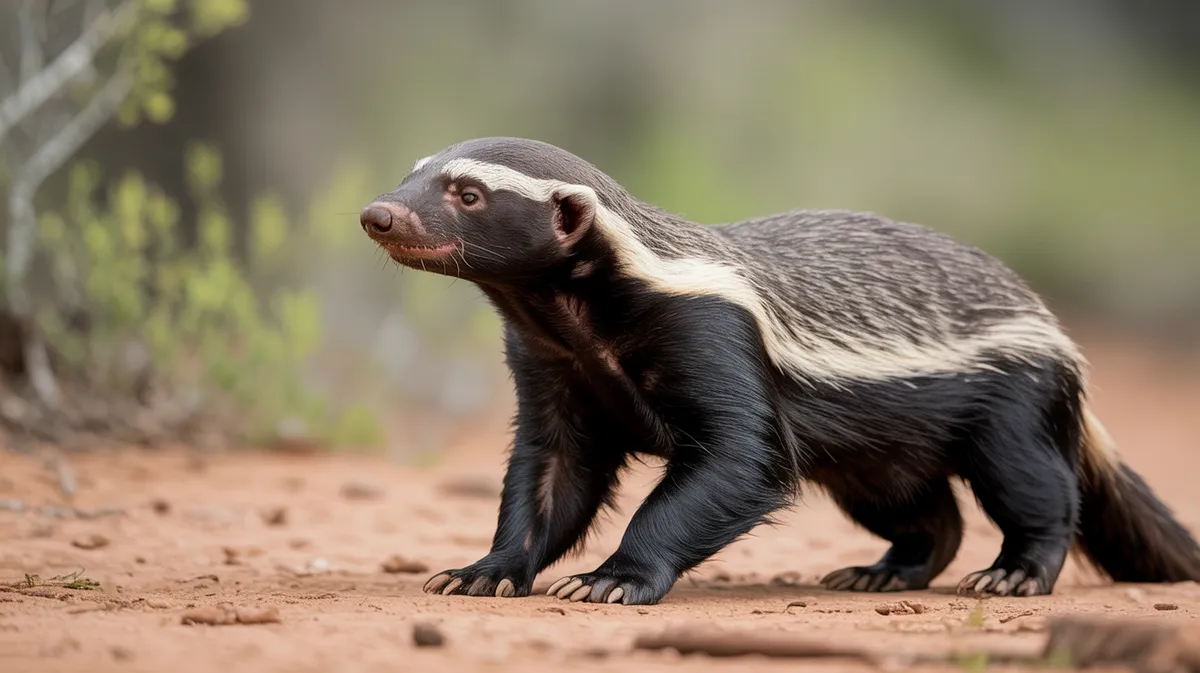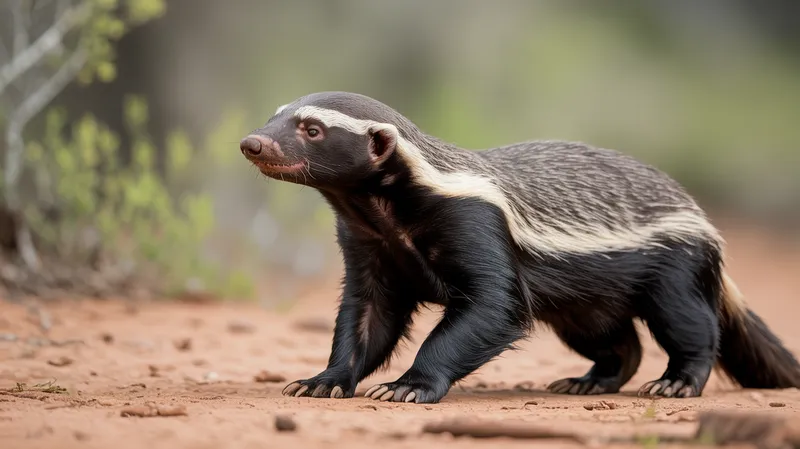
Honey Badger
Mellivora capensis

Meet the Honey Badger
The honey badger, also known as the ratel, is a fearless and tough carnivorous mammal native to Africa, Southwest Asia, and the Indian subcontinent. Its thick, loose skin and stocky build protect it from bites and stings, while its sharp claws and strong jaws make it an effective predator and scavenger. Renowned for its intelligence and audacity, the honey badger is capable of raiding beehives, preying on venomous snakes, and even facing down much larger animals. Its adaptability allows it to thrive in a wide range of environments, from arid savannas and grasslands to forests and mountains. Despite its reputation, the honey badger is generally solitary and primarily nocturnal, using its keen sense of smell to locate food.
Classification
Mammal
Habitat
Savanna, grassland, forest, and scrubland
Diet
Carnivore
Lifespan
7-10 years in the wild
Conservation
Least Concern
Weight
9-16 kg
📖Fascinating Facts
Tough Skin
The honey badger's skin is extremely thick and loose, allowing it to twist and turn on attackers even when being bitten or grabbed.
Beehive Raider
Honey badgers often raid beehives for honey and bee larvae, enduring hundreds of stings in the process thanks to their immunity to venom.
Venom Resistance
They can survive bites from highly venomous snakes such as cobras, as their bodies have adapted to neutralize toxins.
📋Detailed Description
The honey badger (Mellivora capensis) is a robust, medium-sized mustelid distinguished by its stocky build, broad back, and a coat that is characteristically black with a contrasting pale gray or white mantle extending from the top of the head to the base of the tail. Adults typically measure 55–77 cm in body length, with a tail of 12–30 cm, and weigh between 9 and 16 kg, with males being noticeably larger than females. The skin is exceptionally thick and loose, particularly around the neck and shoulders, allowing the animal to twist and bite attackers even when seized. Its powerful forelimbs are equipped with long, curved claws adapted for digging and tearing apart prey or beehives. The skull is broad and robust, with strong jaw muscles and dentition capable of crushing bone and cracking open hard-shelled prey. Honey badgers possess small eyes and ears, but a highly developed sense of smell. They are primarily solitary, with individuals occupying large home ranges that can overlap. Notably, the honey badger is renowned for its intelligence, problem-solving abilities, and boldness, often displaying little fear of larger predators. Its diet is highly varied, and it is both a proficient hunter and opportunistic scavenger. The species is highly adaptable, occupying diverse habitats from arid deserts to dense forests, and is active mainly at night, though diurnal activity is observed in areas with low human disturbance.
💡 Did you know?
Despite their name, honey badgers are not closely related to true badgers but are the only species in their own genus, Mellivora.
🔬Research & Sources
Wikipedia Summary
The honey badger, also known as the ratel, is a mammal widely distributed across Africa, Southwest Asia, and the Indian subcontinent. It is the only living species in both the genus Mellivora and the subfamily Mellivorinae. It has a fairly long body, with a distinctly thick-set and broad back, and remarkably loose skin, allowing the badger to turn and twist freely within it. The largest terrestrial mustelid in Africa, the honey badger measures 55 to 77 cm long and weighs up to 16 kg (35 lb). Sexual dimorphism has been recorded in this species, with males being larger and heavier than females. There are two pairs of mammae, and an anal pouch which, unusual among mustelids, is eversible, a trait shared with hyenas and mongooses.
Last Modified: 6/7/2025
🎭Behavior & Social Structure
Honey badgers are predominantly solitary and territorial, marking their ranges with scent from their eversible anal pouch. They are primarily nocturnal in areas with human presence but may be diurnal in undisturbed regions. Their daily routine involves extensive foraging, often covering several kilometers in search of food. They are known for their relentless and methodical hunting style, digging out burrowing animals, raiding beehives, and climbing trees to access prey or honey. Their diet includes rodents, birds, reptiles (notably venomous snakes), insects, eggs, fruit, and carrion. Honey badgers exhibit remarkable problem-solving skills, such as using tools or manipulating objects to access food. Social interactions are limited outside of mating and maternal care, though temporary associations may occur in resource-rich areas. Vocalizations include grunts, growls, and hisses, used primarily in aggressive or defensive contexts.
👶Reproduction & Life Cycle
Honey badgers are generally solitary except during the breeding season or when females are caring for young. Breeding can occur year-round, though peaks have been observed in some regions, often linked to rainfall and prey abundance. Mating is brief and can be aggressive, with males sometimes following females for several days. Gestation lasts approximately 6–8 weeks (about 50–70 days), after which the female gives birth to 1–2 cubs in a concealed burrow. Cubs are born blind and helpless, opening their eyes at around 2 weeks and beginning to leave the den at 2–3 months. Maternal care is intensive, with the mother frequently relocating the den to avoid predators. Cubs remain with the mother for up to 12–16 months, learning essential hunting and survival skills before becoming independent.
🛡️Adaptations & Survival
The honey badger exhibits several remarkable adaptations for survival. Its thick, loose skin provides protection from bites, stings, and allows escape from predators' grips. The eversible anal pouch can emit a strong-smelling secretion, used for territorial marking and potentially for deterring predators. Immunological adaptations grant resistance to many snake venoms, including those of cobras and puff adders, allowing honey badgers to prey on venomous snakes with reduced risk. Their powerful forelimbs and claws are specialized for digging, both for food and for creating burrows. Behavioral flexibility and intelligence enable them to exploit a wide range of food sources and habitats. Their aggressive temperament and fearlessness further deter most predators, including large carnivores.
📚Research Sources
🎨Cultural Significance
The honey badger holds a prominent place in African folklore and popular culture, often symbolizing fearlessness, tenacity, and cunning. In some traditions, it is revered for its boldness and ability to overcome larger adversaries. The animal has also gained international fame through viral media and documentaries, further cementing its reputation as one of the most fearless animals. In certain regions, body parts or fat have been used in traditional medicine, though this practice is not widespread. The honey badger is also the namesake for military vehicles and sports teams, reflecting its symbolic association with toughness and resilience.
🔬Recent Research & Discoveries
Recent research has focused on the honey badger's resistance to snake venom, revealing unique mutations in the nicotinic acetylcholine receptor that confer partial immunity. Studies using GPS tracking have provided new insights into their large home ranges, movement patterns, and habitat use. Behavioral research has documented advanced problem-solving abilities, including tool use in captivity and complex foraging strategies in the wild. Ongoing studies are examining the ecological role of honey badgers as mesopredators and their interactions with other carnivores. Conservation research is increasingly focused on mitigating human-wildlife conflict, particularly with beekeepers, through the development of honey badger-proof hives and community engagement programs.
🎥Wildlife Videos

Stoffel, the honey badger that can escape from anywhere! - BBC
Subscribe and to the BBC https://bit.ly/BBCYouTubeSub Watch the BBC first on iPlayer https://bbc.in/iPlayer-Home Honey ...
BBC

Honey Badger - Fearless, Bulletproof and ...almost Immortal?
Get ready for jaw-dropping encounters as the fearless Honey Badger takes on Africa's most formidable predators!
Magic of Nature

The Honey Badger – Nature’s Most Fearless Animal | Wildlife Documentary
The Honey Badger – Nature's Most Fearless Animal | Wildlife Documentary The Honey Badger – Nature's Most Fearless Animal ...
The Hybrid League

Most Unbelievable Attacks Of Honey Badger On Earth Ever Recorded | Animal Fighting
Most Unbelievable Attacks Of Honey Badger On Earth Ever Recorded | Animal Fighting Experience the astonishing prowess of ...
VWildlife

Honey Badgers Don't Care
This creature is one durable son of a gun. And even though it looks like an overgrown weasel, it's fierce, smart and shouldn't be ...
Crazy Creatures

Honey Badger Takes Savagery to a Whole New Level #HoneyBadgerUnleashed
Honey badgers are the Italian mafia of the animal kingdom. No one, and I mean no one, wants to mess with these savages.
Wildacious
🌍Habitat Information
The Honey Badger typically inhabits Savanna, grassland, forest, and scrubland environments. Honey Badgers have adapted to their environments with specialized features and behaviors.
Primary Habitat:
Savanna, grassland, forest, and scrubland
More detailed habitat information will be available soon.
🛡️Conservation Status
The Honey Badger is currently classified as Least Concern. Conservation efforts are crucial for preserving this species for future generations.
Common Threats:
- 🏠Habitat loss and fragmentation
- 🌡️Climate change impacts
- 🎯Hunting and poaching
- 🏭Human-wildlife conflict
⚠️Threats & Conservation Challenges
Despite their resilience, honey badgers face several threats. Habitat loss and fragmentation due to agriculture, urbanization, and infrastructure development reduce available territory. They are sometimes persecuted by beekeepers and poultry farmers due to their raids on hives and livestock. Accidental poisoning and trapping, particularly from rodenticides and snares intended for other species, also pose risks. Road mortality is a localized threat in some regions. However, the species remains widespread and adaptable, with stable populations in many areas. The IUCN currently lists the honey badger as Least Concern, though local declines have been noted where human-wildlife conflict is intense.
🔬Scientific Classification
Scientific Name
Mellivora capensis
Classification Hierarchy
🔍 About Taxonomic Classification
Taxonomic classification is a hierarchical system used by scientists to classify and organize living organisms based on shared characteristics and evolutionary relationships.
The system moves from broad categories (Kingdom) to increasingly specific ones, with each animal's scientific name typically consisting of its Genus and species.
📝Community Notes
Share your observations and insights about the Honey Badger with our community of wildlife enthusiasts.
Join Our Community
Sign in to share your observations and connect with fellow wildlife enthusiasts.
Sign In to ContributeNo community notes yet
Be the first to share your observations about the Honey Badger!
Explore Honey Badger
Select a tab above to learn more about this amazing animal.
📸Photo Gallery
No photos available for this animal yet.
🌟Discover More Wildlife
Continue your journey of discovery with more fascinating animals from our database
